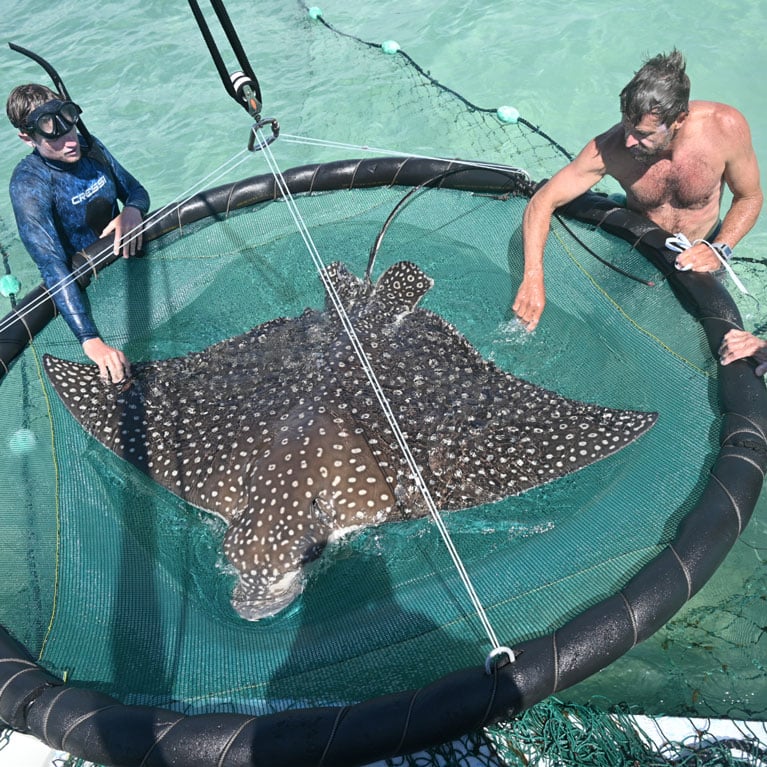Close-kin and eagle ray conservation
John is developing new ways to count endangered, white-spotted eagle rays in the Eastern Gulf of Mexico. Called close-kin mark-recapture, the method combines the latest in genomics and statistics to assess shark and ray populations. Once refined, the method may allow us to understand the scale of spotted eagle ray population declines
I don’t know why or where it came from, but I have felt drawn to the ocean and captivated by elasmobranchs (sharks and rays) for as long as I can remember. Over the years, as I studied elasmobranch biology and sought opportunities to interact with the animals, my casual interest transformed into a passion; the more I’ve learnt, the more I’ve come to realise how exceptional sharks and rays are. Their uniqueness arises from their evolutionary history. Sharks and rays (and chimaeras) took their own evolutionary path relative to other vertebrates about 450 million years ago. This does...


Counting eagle rays with close-kin mark-recapture
Close-kin mark-recapture (CKMR) is a DNA-based method for estimating population abundance that has the potential to greatly improve how elasmobranch populations are monitored and managed. The ultimate goal of this project is to use close-kin mark-recapture to estimate absolute abundance of spotted eagle rays in the Eastern Gulf of Mexico while developing resources and protocols that will help other elasmobranch researchers integrate this promising tool into their toolkit.
This project is unique because it combines cutting-edge genomic techniques with new advances in statistical modeling to address a critical issue that has plagued effective elasmobranch conservation for decades: estimating population abundance. As CKMR grows in popularity among elasmobranch researchers, it is important to clarify the data requirements of the models while demonstrating how the findings translate into real-world applications.
Whitespotted eagle rays (Aetobatus narinari) are a globally endangered species that have experienced global population reductions between 50%-79% over the last thirty years. In circumstances where sufficient samples and metadata have been collected, CKMR may help us understand the scale of these reductions, thereby improving the data available to inform eagle ray conservation and management.
Eagle rays in the Eastern Gulf of Mexico are largely protected from fishing pressure – one of the primary drivers of population declines worldwide – but remain susceptible to habitat loss, prey loss, and toxic algal blooms. Fortunately, researchers have been collecting non-lethal tissue samples from the population for over a decade and, during this time, have gathered ample data to inform the construction of a CKMR model. With the various conservation concerns facing the species, as well as the availability of samples and life history data for the population, eagle rays in the Eastern Gulf of Mexico are a prime candidate for real-world application of CKMR.
The threats facing elasmobranchs are numerous and complex, from targeted fishing for consumption, to non-target removal as bycatch and recreational fishing for sport, all of which contribute to the alarming decline of elasmobranch populations. As solutions are sought and ways to implement them explored, populations continue to be exploited at rates that are difficult to quantify because tracking the abundance of these elusive animals has proven very difficult. This makes it challenging to manage elasmobranch populations in a sustainable way. However, recent breakthroughs in technology may offer a solution to this conundrum.
Close-kin mark-recapture (CKMR) is an emerging approach that is likely to revolutionize elasmobranch conservation. CKMR fuses the burgeoning fields of genomics and population modelling by analyzing genomic data in a mark-recapture framework to give estimates of population abundance and survival. Importantly, CKMR can be applied in settings where samples are obtained lethally or non-lethally, making it useful for species that are culled as bycatch and also endangered species that are caught and released alive. Further, CKMR allows researchers to estimate adult abundance using samples from juveniles alone, and therefore could be a great tool for researchers studying elasmobranchs that are most easily caught as juveniles in nursery habitats.
Though the method has been applied to a handful of elasmobranch populations already, the widespread adoption of this technique would be assisted by guidelines regarding how to apply it effectively. The overarching goal of this project is to examine the data requirements of CKMR models for elasmobranchs with varied, often complex life histories using simulation, and then apply the method to a species of conservation concern: whitespotted eagle rays. In so doing, we will develop a set of best practice guidelines for constructing CKMR models to estimate abundance of elasmobranch populations. Once the data requirements are clarified, CKMR can potentially be used to estimate abundance of other threatened species for which robust tissue collections already exist, including critically endangered smalltooth sawfish. In the end, we hope this project will encourage elasmobranch researchers to incorporate this promising technique into their research programs.
- Short-term project aim: Generate high-throughput DNA sequence data for a representative subset of eagle ray samples to identify regions of the genome that are informative for identification of relatives (e.g. parent-offspring, half-sibling). These markers will serve as targets for high-throughput genotyping panels that capture these regions and facilitate DNA sequencing at the scale required for CKMR.
- Long-term project aim: estimate abundance of spotted eagle rays in the Eastern Gulf of Mexico using CKMR.

